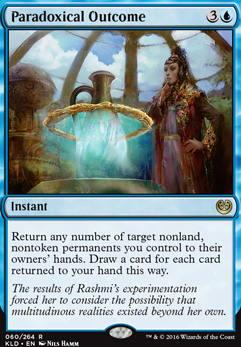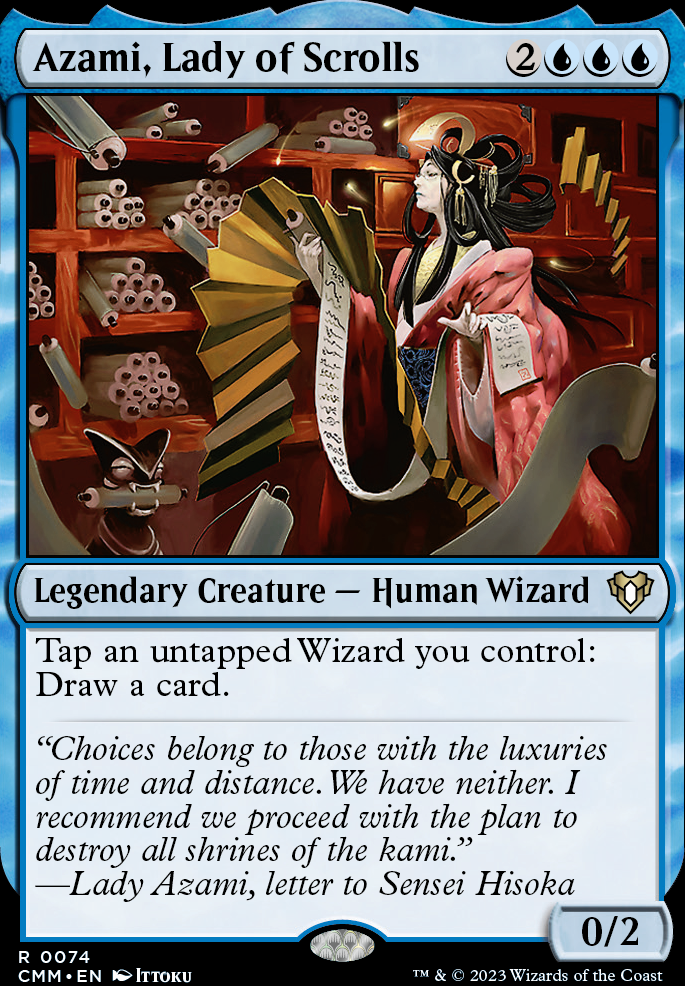Instant (35)
-
1x
Anticipate

- 1x Brainstorm
- 1x Capsize
- 1x Chain of Vapor
- 1x Counterspell
-
1x
Cyclonic Rift

- 1x Daze
- 1x Delay
-
1x
Dig Through Time

-
1x
Dramatic Reversal

- 1x Flusterstorm
- 1x Force of Will
-
1x
Frantic Search

- 1x Gush
- 1x High Tide
-
1x
Impulse

-
1x
Lazotep Plating

- 1x Mana Drain
- 1x Misdirection
-
1x
Mission Briefing

-
1x
Muddle the Mixture

- 1x Mystical Tutor
-
1x
Narset's Reversal
 *f-pre*
*f-pre*
-
1x
Opt

- 1x Pact of Negation
-
1x
Paradoxical Outcome

- 1x Reality Shift
- 1x Remand
-
1x
Repeal

- 1x Snap
-
1x
Spell Pierce

- 1x Supreme Will
-
1x
Swan Song

- 1x Turnabout
- 1x Whir of Invention
Artifact (14)
- 1x Chrome Mox
- 1x Fellwar Stone
- 1x Isochron Scepter
- 1x Lotus Petal
- 1x Mana Crypt
- 1x Mana Vault
-
1x
Mind Stone

- 1x Mox Diamond
- 1x Mox Opal
- 1x Paradox Engine
- 1x Sapphire Medallion
- 1x Sensei's Divining Top
- 1x Sol Ring
- 1x Thought Vessel
Creature (9)
-
1x
Baral, Chief of Compliance

- 1x Glen Elendra Archmage
- 1x Jace, Vryn's Prodigy Flip
- 1x Laboratory Maniac
-
1x
Siren Stormtamer

- 1x Snapcaster Mage
-
1x
Spellseeker

-
1x
Tribute Mage

- 1x Walking Ballista
Sorcery (8)
Commander (1)
Land (30)
- 1x Ancient Tomb
- 1x Buried Ruin
-
1x
Cavern of Souls

- 1x Cephalid Coliseum
- 1x Flooded Strand
-
1x
Inventors' Fair

- 17x Island
- 1x Minamo, School at Water's Edge
- 1x Misty Rainforest
- 1x Polluted Delta
- 1x Prismatic Vista
- 1x Scalding Tarn
- 1x Scavenger Grounds
- 1x Seat of the Synod
Planeswalker (2)
Enchantment (1)
Suggestions
Updates Add
Comments
Attention! Complete Comment Tutorial! This annoying message will go away once you do!
Important! Formatting tips — Comment Tutorial — markdown syntax
Please login to comment
| Date added | 7 years |
| Last updated | 4 years |
| Legality | This deck is not Commander / EDH legal. |
| Rarity (main - side) | 8 - 0 Mythic Rares 32 - 0 Rares 20 - 0 Uncommons 23 - 0 Commons |
| Cards | 100 |
| Avg. CMC | 2.16 |
| Tokens | Bird 2/2 U, Emblem Jace, Vryn's Prodigy, Manifest 2/2 C, Zombie Army 0/0 B |
| Folders | edh, DAMN, cEDH, cEDH, Resources, Want to Build |
| Votes | |
| Ignored suggestions | |
| Shared with | |
| Views |


